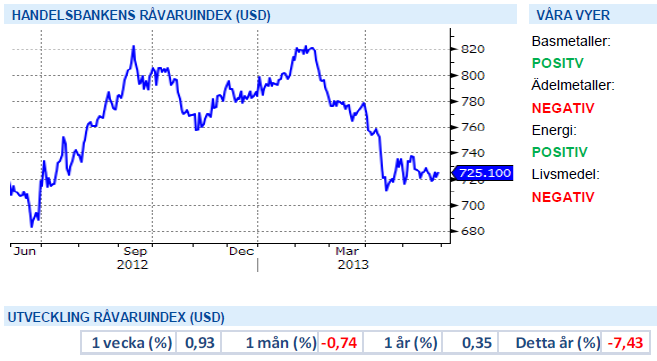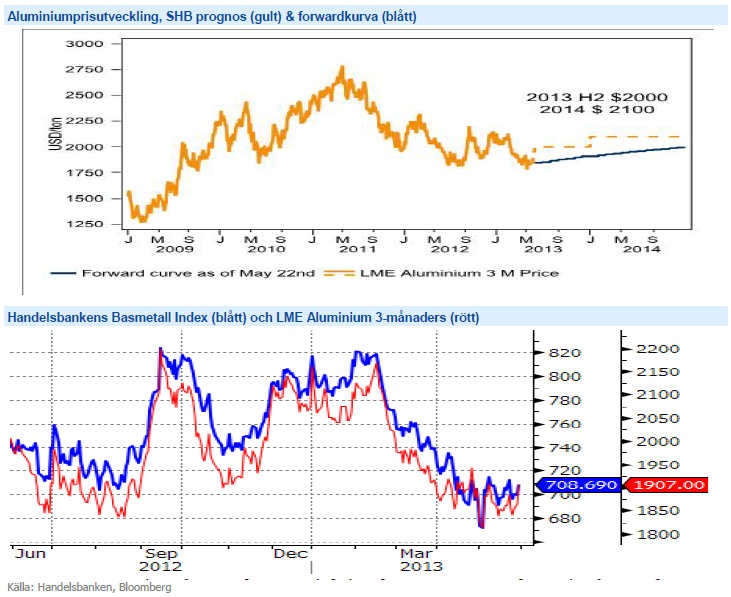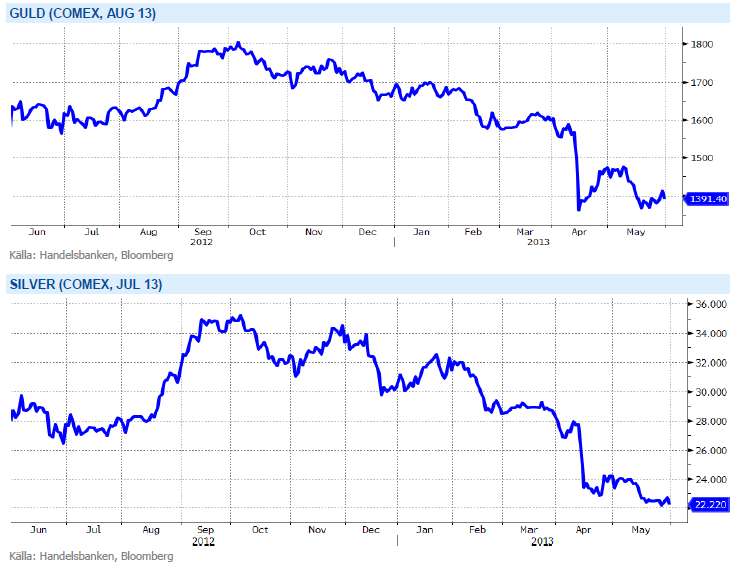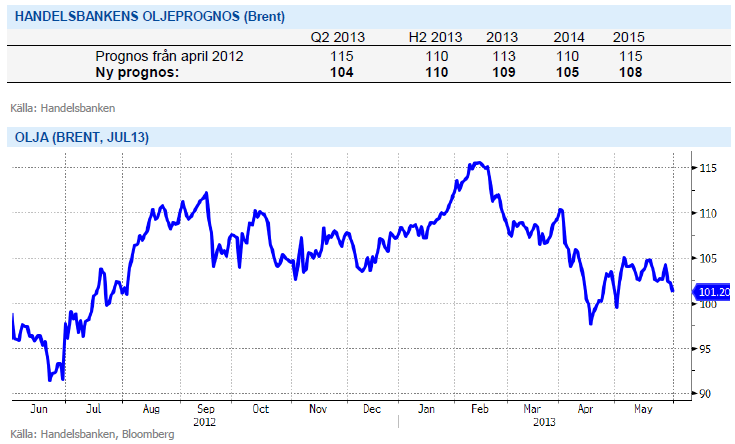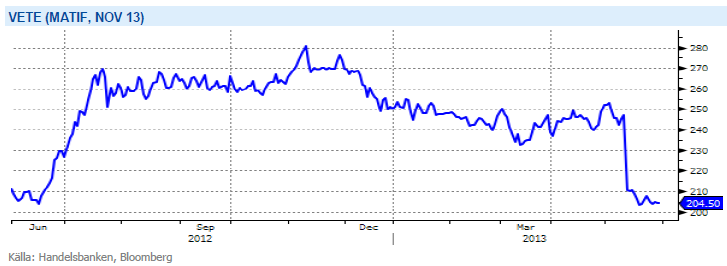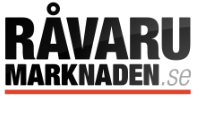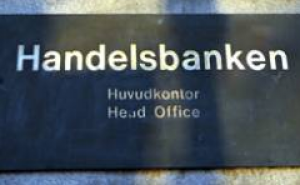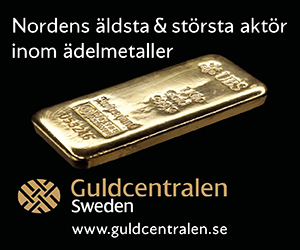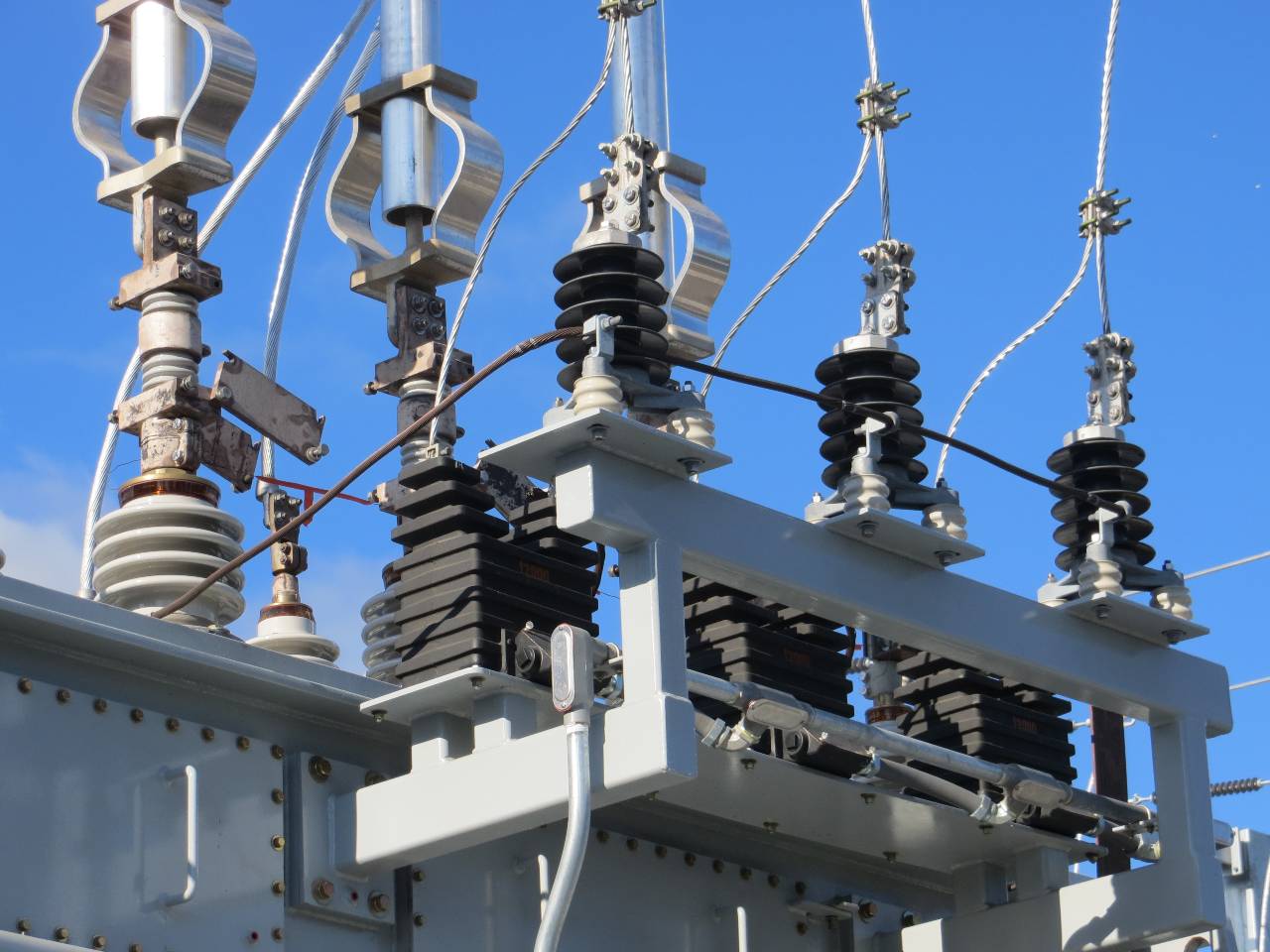Analys
SHB Råvarubrevet 31 maj 2013
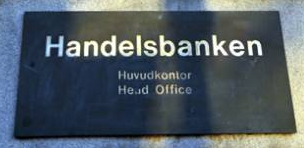
 Råvaror allmänt
Råvaror allmänt
Dagen före dopparedagen
Denna vecka har makromässigt varit lätt och en uppladdning för morgondagens kinesiska inköpschefsindex och USA:s dito som kommer på måndag. Kinas preliminära siffra var svagare än väntat och förväntningarna på morgondagens siffra är 50.0 att jämföra med utfallet för april på 50.6. I USA har konsumtionsdata varit bra på sistone och den felande länken just nu är att inköpschefsindex som mer speglar tillverkningsindustrins konjunktur inte har visat samma styrka. Om den amerikanska siffran kommer in på bra nivåer så kommer vi förkasta vår oro under senvåren för den amerikanska konjunkturen då både husmarknaden och konsumtionen varit bra.
Annars har marknaden känt av volatilitet efter att Fed chefen hintade om eventuellt nedskuret stöd till marknaden redan under tredje kvartalet. Metallerna har varit speciellt volatila på denna signal och USA:s stödpolitik är svår att bedöma just nu. Generellt kan man säga att USA har fått en klart starkare betydelse för råvarumarknaden den här våren efter att förväntningarna på Kina fallit samtidigt som de trissats upp på USA.
Kinesiska data fortsätter vara något svagare än väntat med lägre aktivitet över lag. Få eller inga signaler om ytterligare stimulanser gör att marknaden kontinuerligt sänker förväntningarna på Kina. Problembarnet Europa fortsätter på svaga nivåer och indikatorer pekar på recession, men i alla fall en mildare sådan än för några månader sedan. Givet att förväntansbilden nu är så lågt ställd på Europa så tror vi snarare att Europeisk data har potential att överraska åt det positiva hållet i närtid.
Basmetaller
Basmetallerna finner stöd
Vårt Basmetallindex ligger kvar oförändrat över veckan efter att Aluminium, Zink och Bly stigit medan övriga basmetaller fallit tillbaka något. Freeport-McMoran har återstartat en viss del av produktionen vid Grasberg (Koppar) i Indonesien efter explosionen tidigare i maj där 28 gruvarbetare miste livet. Vidare noteras att Kinesiska myndigheter håller på att utveckla en plan för att minska överkapaciteten inom stål- och aluminiumsektorn i landet där kapacitetsutnyttjandet för närvarande ligger kring 70 procent. En del mindre verk i Hebeiprovinsen har stängts ned de senaste veckorna vilket i sin tur bidragit till att pressa järnmalmen med hela 19 procent sedan mitten av april. Vi uppskattar att ca 25 av aluminiumproduktionen idag sker till förlust och man successivt stänger ned äldre kapacitet.
Bland metallerna håller vi Aluminium som en liten favorit inte minst om man tittar på den tekniska bilden. Nedan ser ni prisutvecklingen samt marknadens forwardpris i blått och vår egen prognos i gult.
Den fysiska marknaden för basmetaller är stark och efter vårens nedgång ser vi basmetallerna som köpvärda på dessa nivåer. Vi tror på: LONG BASMET H
Ädelmetaller
På guldfronten intet nytt!
En vecka med stora börssvängningar i Japan framför allt, som trots en stark avslutning stänger ner nästan 6 % har präglat marknaden. Generellt minskad riskaptit har lockat in en del nya köpare i guldet, och i skrivande stund noteras den ädla metallen drygt 2 % högre än förra veckan. Vi bibehåller vår negativa syn, veckan som gått borde ha stärkt guldet betydligt mer än vad som skett, särskilt mot bakgrund av att veckan också bjudit på en ganska ordentlig dollarförsvagning.
Vi ser det fortfarande som att guldmarknaden är ”lång” i sin positionering, och uppgångarna blir än så länge beskedliga och kortlivade, i en miljö som borde passa guldet. Vi vill påminna om att guldprisets uppgång bygger på att det hela tiden tillkommer nya köpare som är beredda att betala mer än föregående köpare. När priset istället – som de senaste månaderna – faller, då blir det svårt att motivera långa positioner. Till skillnad från övriga råvaror, som faktiskt går åt till något, så är det få guldinvesterare som förbrukar sitt guld. Det är inte kul att smälta ner guldtackan och göra ett örhänge för att priset faller.
Urprisningen av QE driver ner guldet ytterligare samtidigt som dollarn stärks – vilket i sin tur ger lägre guld. Vi tror på: SHRT GULD H
Energi
OPEC håller produktionen oförändrad
Fokus var denna vecka på OPECs möte i Wien och huruvida man skulle komma att dra ner produktionen för att balansera överskottet i marknaden. Disciplinen har blivit bättre inom OPEC bland medlemsländerna men man producerar fortfarande mer än målet om 30 miljoner fat per dag. Saudiarabien producerar på högsta nivån sedan november 2012, dvs 9.35 miljoner fat per dag, vilket gör det svårt för dem att tvinga andra medlemmar att dra ned sin produktion. OPEC beslutade därför vid sitt möte i Wien att hålla produktionsmålet om 30 miljoner fat per dag oförändrat, trots att det bidrar till överskottet. I övrigt var det mest effekterna av den amerikanska skifferproduktionen som stod i fokus. Skiffer-produktionen minskar det amerikanska importbehovet vilket i sin tur leder till en större konkurrens kring marknadsandelar i Asien för OPECs medlemmar. Oljan backar med en dollar under veckan bla till följd av EIA´s lagersiffror som visade på en ökning mot förväntan till rekordhöga nivåer.
Sidledes utveckling på den Nordiska elmarknaden där den inledande handeln präglats av våta väderprognoser men där prognoserna svängt om mot ett något torrare scenario (energibalansen landar på ca -9 TWh). Ser vi till bränslekomplexet så balanseras ett vikande kolpris av stigande gaspriser och en stabiliserad utsläppsmarknad så för att sammanfatta är det egentligen bara kolet som verkar för nedsidan. Vi räknar dock med att elmarknaden handlas kvar på nuvarande nivåer.
Livsmedel
Kommande skörd väntas bli hög
Priserna på majs i Chicago för ny skörd har gått upp under veckan, påverkat främst av att regn fördröjer den sista delen av den amerikanska sådden. Det är dock en liten del av sådden som återstår nu och regnet gynnar redan sådd gröda. Väderprognosen för kommande vecka är ganska osäker men inte mycket lär återstå av sådden när vi kommit en bit in i veckan. Andelen av grödan som nått uppkomststadiet ligger efter det normala men hopp finns om en återhämtning även där. I Argentina fortsätter skörden utan större problem i torrt och varmt väder, omkring 80 procent av skörden uppges nu vara klar. Kommande prisbild kommer vara väldigt beroende av utvecklingen för grödan i USA och än finns alla chanser för att kommande skörd blir hög.
Vetepriset handlats på veckan i princip oförändrat. Det amerikanska höstvetet har fått en del regnskurar men framförallt har temperaturen stigit, vilket bör gynna grödorna något. En del regnskurar fortsätter att fördröja den amerikanska vårsådden men andelen av sådden som är avklarad ligger nu inte långt efter genomsnittet för de senaste fem åren och ingen större oro verkar finnas. Mer regn fortsätter även att störa sådden i Kanada men generellt upplevs mer torrt än blött väder. I EU är fortfarande generellt sett ganska kallt och regnigt, vilket gör att inte mycket händer med de redan sent utvecklade grödorna. Mer värme och sol önskas och ser också ut att komma i nästa vecka. Kommande prisutveckling är väldigt beroende av vädret den närmsta tiden, inte minst för majsen i USA men även i Europa där värmen behövs. I dagsläget upplevs dock större problem enbart för det amerikanska vetet. Mycket kan hända innan skörd men i dagsläget är vi kvar i vår tro om större skördar och ökade lagernivåer med lägre priser längre fram på året som följd.
Efter att alla frön är i jorden och prognoser på rekordskördar duggar tätt så finns alla förutsättningar för att priserna på de tre stora grödorna soja, majs och vete att falla fram till skörden är bärgad. Vi tror på: SHRT LIVSMEDEL H
Handelsbankens Råvaruindex
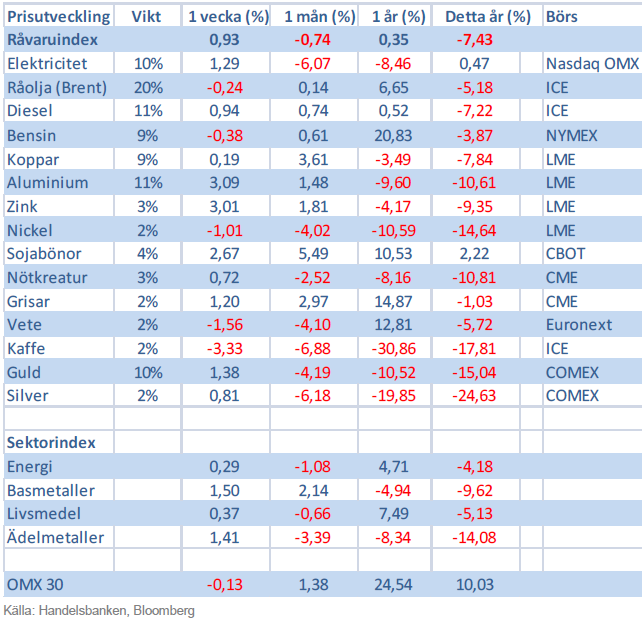
Handelsbankens råvaruindex består av de underliggande indexen för respektive råvara. Vikterna är bestämda till hälften från värdet av nordisk produktion (globala produktionen för sektorindex) och till hälften från likviditeten i terminskontrakten.
[box]SHB Råvarubrevet är producerat av Handelsbanken och publiceras i samarbete och med tillstånd på Råvarumarknaden.se[/box]
Ansvarsbegränsning
Detta material är producerat av Svenska Handelsbanken AB (publ) i fortsättningen kallad Handelsbanken. De som arbetar med innehållet är inte analytiker och materialet är inte oberoende investeringsanalys. Innehållet är uteslutande avsett för kunder i Sverige. Syftet är att ge en allmän information till Handelsbankens kunder och utgör inte ett personligt investeringsråd eller en personlig rekommendation. Informationen ska inte ensamt utgöra underlag för investeringsbeslut. Kunder bör inhämta råd från sina rådgivare och basera sina investeringsbeslut utifrån egen erfarenhet.
Informationen i materialet kan ändras och också avvika från de åsikter som uttrycks i oberoende investeringsanalyser från Handelsbanken. Informationen grundar sig på allmänt tillgänglig information och är hämtad från källor som bedöms som tillförlitliga, men riktigheten kan inte garanteras och informationen kan vara ofullständig eller nedkortad. Ingen del av förslaget får reproduceras eller distribueras till någon annan person utan att Handelsbanken dessförinnan lämnat sitt skriftliga medgivande. Handelsbanken ansvarar inte för att materialet används på ett sätt som strider mot förbudet mot vidarebefordran eller offentliggörs i strid med bankens regler.
Analys
Brent crude ticks higher on tension, but market structure stays soft
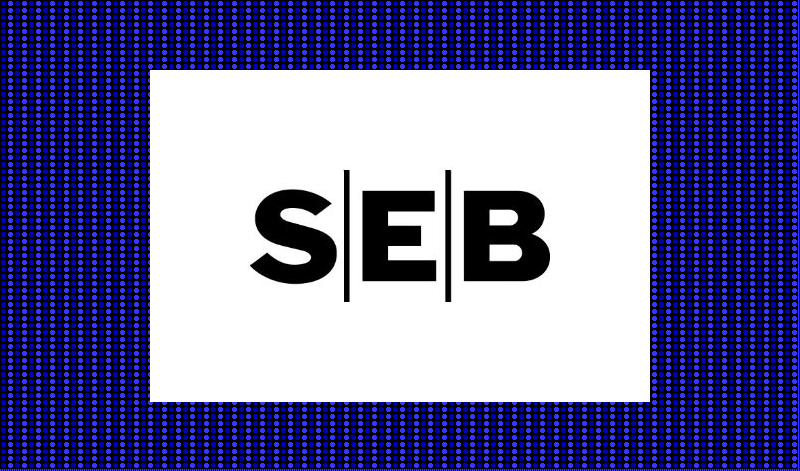
Brent crude has climbed roughly USD 1.5-2 per barrel since Friday, yet falling USD 0.3 per barrel this mornig and currently trading near USD 67.25/bbl after yesterday’s climb. While the rally reflects short-term geopolitical tension, price action has been choppy, and crude remains locked in a broader range – caught between supply-side pressure and spot resilience.

Prices have been supported by renewed Ukrainian drone strikes targeting Russian infrastructure. Over the weekend, falling debris triggered a fire at the 20mtpa Kirishi refinery, following last week’s attack on the key Primorsk terminal.
Argus estimates that these attacks have halted ish 300 kbl/d of Russian refining capacity in August and September. While the market impact is limited for now, the action signals Kyiv’s growing willingness to disrupt oil flows – supporting a soft geopolitical floor under prices.
The political environment is shifting: the EU is reportedly considering sanctions on Indian and Chinese firms facilitating Russian crude flows, while the U.S. has so far held back – despite Bessent warning that any action from Washington depends on broader European participation. Senator Graham has also publicly criticized NATO members like Slovakia and Hungary for continuing Russian oil imports.
It’s worth noting that China and India remain the two largest buyers of Russian barrels since the invasion of Ukraine. While New Delhi has been hit with 50% secondary tariffs, Beijing has been spared so far.
Still, the broader supply/demand balance leans bearish. Futures markets reflect this: Brent’s prompt spread (gauge of near-term tightness) has narrowed to the current USD 0.42/bl, down from USD 0.96/bl two months ago, pointing to weakening backwardation.
This aligns with expectations for a record surplus in 2026, largely driven by the faster-than-anticipated return of OPEC+ barrels to market. OPEC+ is gathering in Vienna this week to begin revising member production capacity estimates – setting the stage for new output baselines from 2027. The group aims to agree on how to define “maximum sustainable capacity,” with a proposal expected by year-end.
While the IEA pegs OPEC+ capacity at 47.9 million barrels per day, actual output in August was only 42.4 million barrels per day. Disagreements over data and quota fairness (especially from Iraq and Nigeria) have already delayed this process. Angola even quit the group last year after being assigned a lower target than expected. It also remains unclear whether Russia and Iraq can regain earlier output levels due to infrastructure constraints.
Also, macro remains another key driver this week. A 25bp Fed rate cut is widely expected tomorrow (Wednesday), and commodities in general could benefit a potential cut.
Summing up: Brent crude continues to drift sideways, finding near-term support from geopolitics and refining strength. But with surplus building and market structure softening, the upside may remain capped.
Analys
Volatile but going nowhere. Brent crude circles USD 66 as market weighs surplus vs risk

Brent crude is essentially flat on the week, but after a volatile ride. Prices started Monday near USD 65.5/bl, climbed steadily to a mid-week high of USD 67.8/bl on Wednesday evening, before falling sharply – losing about USD 2/bl during Thursday’s session.

Brent is currently trading around USD 65.8/bl, right back where it began. The volatility reflects the market’s ongoing struggle to balance growing surplus risks against persistent geopolitical uncertainty and resilient refined product margins. Thursday’s slide snapped a three-day rally and came largely in response to a string of bearish signals, most notably from the IEA’s updated short-term outlook.
The IEA now projects record global oversupply in 2026, reinforcing concerns flagged earlier by the U.S. EIA, which already sees inventories building this quarter. The forecast comes just days after OPEC+ confirmed it will continue returning idle barrels to the market in October – albeit at a slower pace of +137,000 bl/d. While modest, the move underscores a steady push to reclaim market share and adds to supply-side pressure into year-end.
Thursday’s price drop also followed geopolitical incidences: Israeli airstrikes reportedly targeted Hamas leadership in Doha, while Russian drones crossed into Polish airspace – events that initially sent crude higher as traders covered short positions.
Yet, sentiment remains broadly cautious. Strong refining margins and low inventories at key pricing hubs like Europe continue to support the downside. Chinese stockpiling of discounted Russian barrels and tightness in refined product markets – especially diesel – are also lending support.
On the demand side, the IEA revised up its 2025 global demand growth forecast by 60,000 bl/d to 740,000 bl/d YoY, while leaving 2026 unchanged at 698,000 bl/d. Interestingly, the agency also signaled that its next long-term report could show global oil demand rising through 2050.
Meanwhile, OPEC offered a contrasting view in its latest Monthly Oil Market Report, maintaining expectations for a supply deficit both this year and next, even as its members raise output. The group kept its demand growth estimates for 2025 and 2026 unchanged at 1.29 million bl/d and 1.38 million bl/d, respectively.
We continue to watch whether the bearish supply outlook will outweigh geopolitical risk, and if Brent can continue to find support above USD 65/bl – a level increasingly seen as a soft floor for OPEC+ policy.
Analys
Waiting for the surplus while we worry about Israel and Qatar

Brent crude makes some gains as Israel’s attack on Hamas in Qatar rattles markets. Brent crude spiked to a high of USD 67.38/b yesterday as Israel made a strike on Hamas in Qatar. But it wasn’t able to hold on to that level and only closed up 0.6% in the end at USD 66.39/b. This morning it is starting on the up with a gain of 0.9% at USD 67/b. Still rattled by Israel’s attack on Hamas in Qatar yesterday. Brent is getting some help on the margin this morning with Asian equities higher and copper gaining half a percent. But the dark cloud of surplus ahead is nonetheless hanging over the market with Brent trading two dollar lower than last Tuesday.

Geopolitical risk premiums in oil rarely lasts long unless actual supply disruption kicks in. While Israel’s attack on Hamas in Qatar is shocking, the geopolitical risk lifting crude oil yesterday and this morning is unlikely to last very long as such geopolitical risk premiums usually do not last long unless real disruption kicks in.
US API data yesterday indicated a US crude and product stock build last week of 3.1 mb. The US API last evening released partial US oil inventory data indicating that US crude stocks rose 1.3 mb and middle distillates rose 1.5 mb while gasoline rose 0.3 mb. In total a bit more than 3 mb increase. US crude and product stocks usually rise around 1 mb per week this time of year. So US commercial crude and product stock rose 2 mb over the past week adjusted for the seasonal norm. Official and complete data are due today at 16:30.
A 2 mb/week seasonally adj. US stock build implies a 1 – 1.4 mb/d global surplus if it is persistent. Assume that if the global oil market is running a surplus then some 20% to 30% of that surplus ends up in US commercial inventories. A 2 mb seasonally adjusted inventory build equals 286 kb/d. Divide by 0.2 to 0.3 and we get an implied global surplus of 950 kb/d to 1430 kb/d. A 2 mb/week seasonally adjusted build in US oil inventories is close to noise unless it is a persistent pattern every week.
US IEA STEO oil report: Robust surplus ahead and Brent averaging USD 51/b in 2026. The US EIA yesterday released its monthly STEO oil report. It projected a large and persistent surplus ahead. It estimates a global surplus of 2.2 m/d from September to December this year. A 2.4 mb/d surplus in Q1-26 and an average surplus for 2026 of 1.6 mb/d resulting in an average Brent crude oil price of USD 51/b next year. And that includes an assumption where OPEC crude oil production only averages 27.8 mb/d in 2026 versus 27.0 mb/d in 2024 and 28.6 mb/d in August.
Brent will feel the bear-pressure once US/OECD stocks starts visible build. In the meanwhile the oil market sits waiting for this projected surplus to materialize in US and OECD inventories. Once they visibly starts to build on a consistent basis, then Brent crude will likely quickly lose altitude. And unless some unforeseen supply disruption kicks in, it is bound to happen.
US IEA STEO September report. In total not much different than it was in January
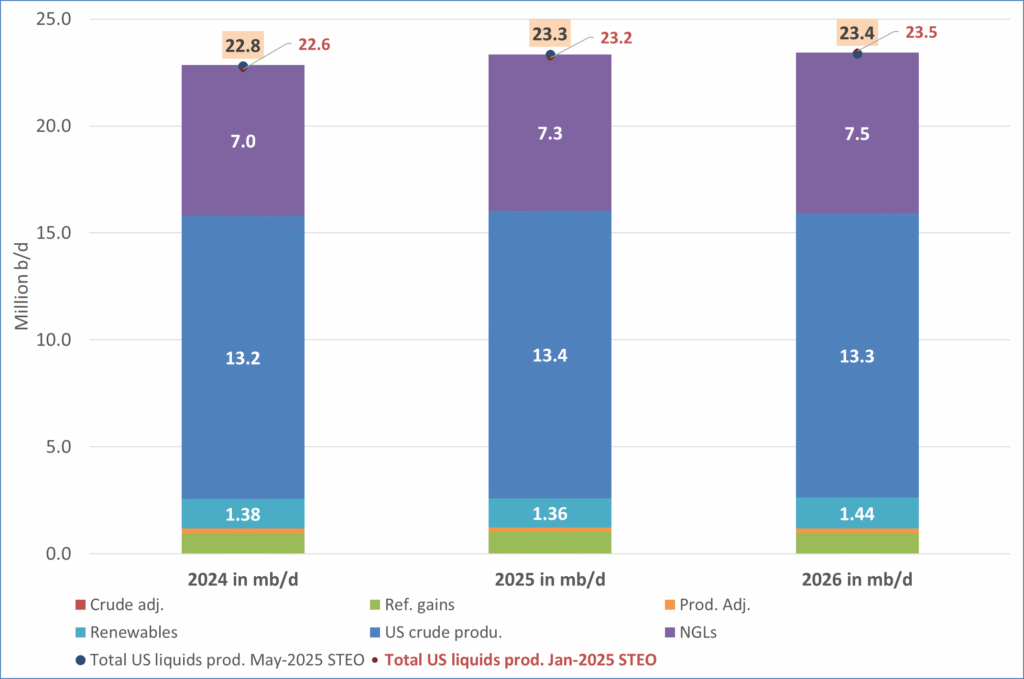
US IEA STEO September report. US crude oil production contracting in 2026, but NGLs still growing. Close to zero net liquids growth in total.
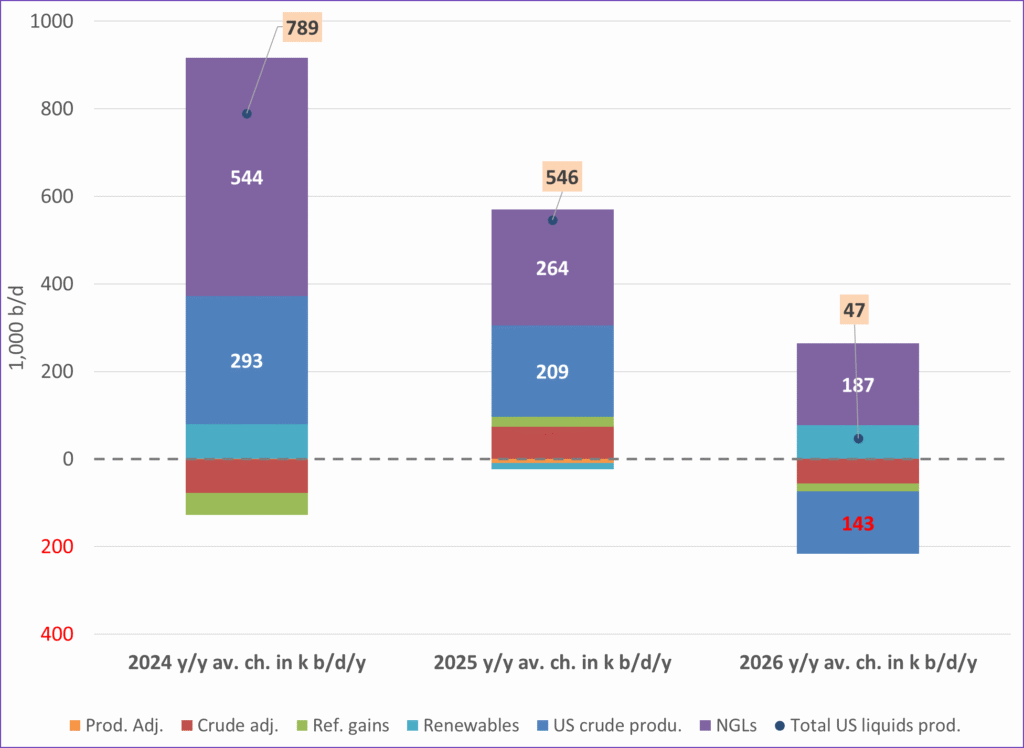
-

 Nyheter4 veckor sedan
Nyheter4 veckor sedanMeta bygger ett AI-datacenter på 5 GW och 2,25 GW gaskraftverk
-
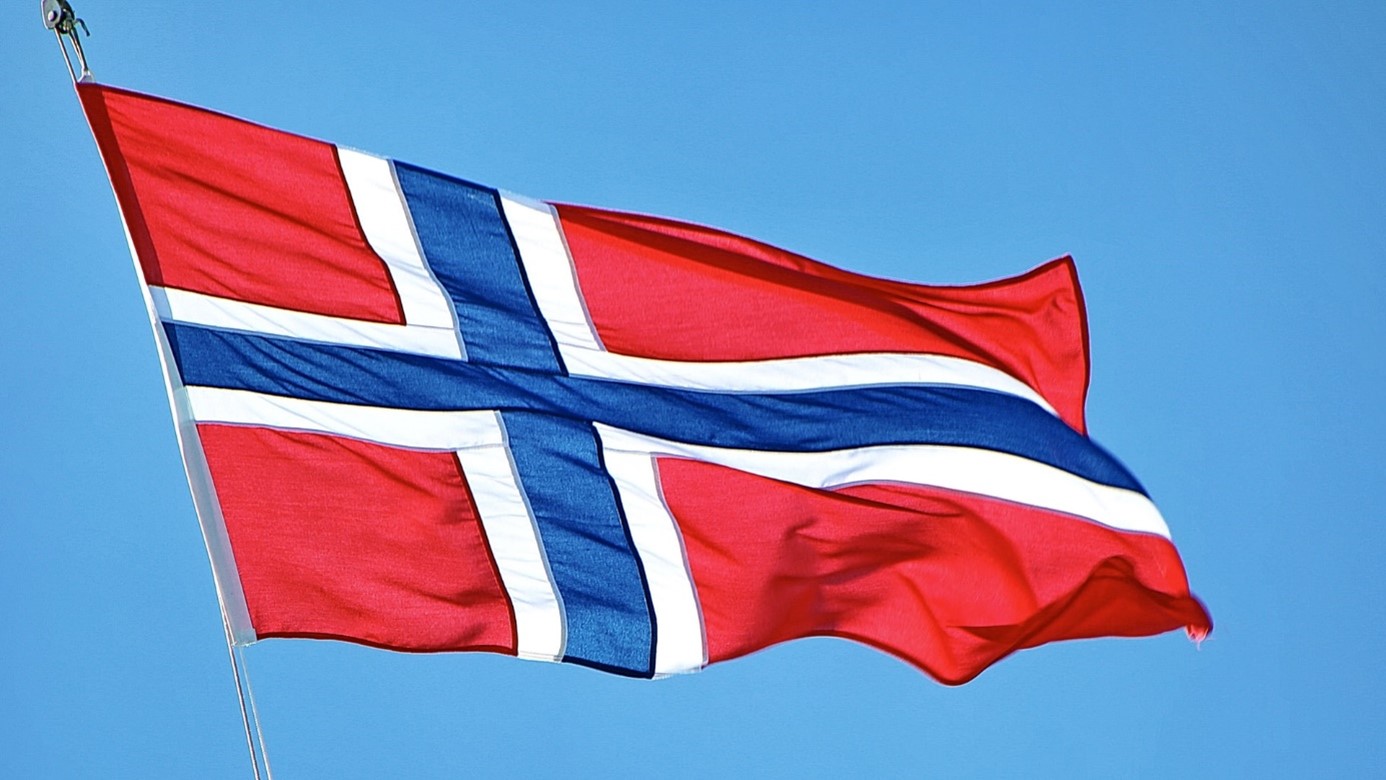
 Nyheter4 veckor sedan
Nyheter4 veckor sedanAker BP gör ett av Norges största oljefynd på ett decennium, stärker resurserna i Yggdrasilområdet
-

 Analys4 veckor sedan
Analys4 veckor sedanBrent sideways on sanctions and peace talks
-

 Nyheter4 veckor sedan
Nyheter4 veckor sedanSommarens torka kan ge högre elpriser i höst
-

 Analys4 veckor sedan
Analys4 veckor sedanBrent edges higher as India–Russia oil trade draws U.S. ire and Powell takes the stage at Jackson Hole
-
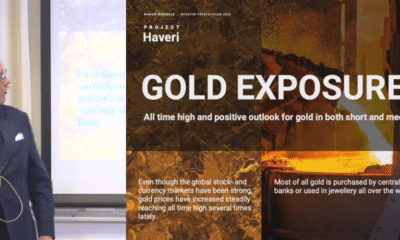
 Nyheter3 veckor sedan
Nyheter3 veckor sedanMahvie Minerals är verksamt i guldrikt område i Finland
-

 Analys3 veckor sedan
Analys3 veckor sedanIncreasing risk that OPEC+ will unwind the last 1.65 mb/d of cuts when they meet on 7 September
-

 Analys2 veckor sedan
Analys2 veckor sedanOPEC+ in a process of retaking market share


